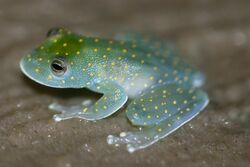Biology:Cochranella
| Cochranella | |
|---|---|

| |
| Cochranella euknemos | |
| Scientific classification | |
| Domain: | Eukaryota |
| Kingdom: | Animalia |
| Phylum: | Chordata |
| Class: | Amphibia |
| Order: | Anura |
| Family: | Centrolenidae |
| Subfamily: | Centroleninae |
| Genus: | Cochranella Taylor, 1951 |
| Type species | |
| Centrolenella granulosa Taylor, 1949
| |
| Species | |
|
8 species (see text) | |
Cochranella is a genus of glass frogs, family Centrolenidae. They are found in Central America from Honduras southward to the Amazonian and Andean cloud forests of Colombia, Ecuador, Peru, and Bolivia.[1]
Etymology
The generic name Cochranella honors Doris Mable Cochran, an American herpetologist.[2][3] Accordingly, common name Cochran frogs has been coined for the genus.[1]
Taxonomy and systematics
Cochranella was first described by Edward Harrison Taylor in 1951. The current delimitation of this genus follows from the work by Juan Manuel Guayasamin and his colleagues published in 2009[1][2] (with some later adjustments[4]). These authors remedied the polyphyly of the genus by partitioning it into several new genera.[1][2]
The diagnostic characteristics of the genus are the following: (1) humeral spines are absent (small spine present in C. litoralis); (2) digestive tract is white (translucent in Cochranella nola) and the lobed liver is covered by a transparent hepatic peritoneum; (3) ventral parietal peritoneum is white anteriorly and transparent posteriorly; (4) webbing between the fingers III–IV is moderate to extensive; (5) bones are green in life; (6) dorsum is lavender in preserved specimens; (7) dentigerous process of the vomer and vomerine teeth are present (absent in C. litoralis); (8) males call from the upper surfaces of leaves and females deposit eggs on the upper sides of leaves along streams; (9) quadratojugal bone is articulating with maxilla.[2]
Species
Currently eight species are placed in this genus:[1]
- Cochranella erminea Torres-Gastello, Suárez-Segovia, and Cisneros-Heredia, 2007
- Cochranella euknemos (Savage and Starrett, 1967)
- Cochranella granulosa (Taylor, 1949)
- Cochranella guayasamini Twomey, Delia, and Castroviejo-Fisher, 2014
- Cochranella litoralis (Ruiz-Carranza and Lynch, 1996)
- Cochranella mache Guayasamin and Bonaccorso, 2004
- Cochranella nola Harvey, 1996
- Cochranella resplendens (Lynch and Duellman, 1973)
The AmphibiaWeb lists 15 Cochranella species,[5] including ones that the Amphibian Species of the World considers as having uncertain placement within the subfamily Centroleninae (Incertae Sedis).[6]
References
- ↑ 1.0 1.1 1.2 1.3 1.4 Frost, Darrel R. (2023). "Cochranella Taylor, 1951". Amphibian Species of the World: An Online Reference. Version 6.1. American Museum of Natural History. https://amphibiansoftheworld.amnh.org/Amphibia/Anura/Centrolenidae/Centroleninae/Cochranella. Retrieved 30 January 2023.
- ↑ 2.0 2.1 2.2 2.3 Guayasamin, J. M.; Castroviejo-Fisher, S.; Trueb, L.; Ayarzagüena, J.; Rada, M.; Vilà, C. (2009). "Phylogenetic systematics of glassfrogs (Amphibia: Centrolenidae) and their sister taxon Allophryne ruthveni". Zootaxa 2100: 1–97. doi:10.11646/zootaxa.2100.1.1. http://www.mapress.com/zootaxa/list/2009/zt02100.html.
- ↑ Beolens, Bo; Watkins, Michael; Grayson, Michael (2013). The Eponym Dictionary of Amphibians. Pelagic Publishing. pp. 43–44. ISBN 978-1-907807-42-8. https://books.google.com/books?id=QJY3BAAAQBAJ&pg=PA43.
- ↑ Castroviejo-Fisher, Santiago; Guayasamin, Juan M.; Gonzalez-Voyer, Alejandro; Vilà, Carles (2014). "Neotropical diversification seen through glassfrogs". Journal of Biogeography 41 (1): 66–80. doi:10.1111/jbi.12208. https://digital.csic.es/bitstream/10261/89113/1/jbi12208.pdf. (Rulyrana erminea renamed as Cochranella erminea)
- ↑ "Centrolenidae". AmphibiaWeb. University of California, Berkeley. 2023. http://amphibiaweb.org/lists/Centrolenidae.shtml.
- ↑ Frost, Darrel R. (2023). "Centroleninae Taylor, 1951". Amphibian Species of the World: An Online Reference. Version 6.1. American Museum of Natural History. https://amphibiansoftheworld.amnh.org/Amphibia/Anura/Centrolenidae/Centroleninae. Retrieved 30 January 2023.
Wikidata ☰ Q868150 entry
 |

